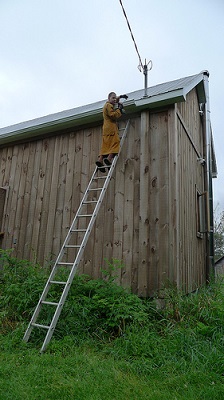Fixing A Hole That Has Appeared On Your Eavestrough
It is easy to not to assume responsibility when a small hole appears in an eaves trough. People tend to leave small issues and only attend to them after they become a big issue. You should never overlook a small hole immediately it appears on your eavestrough because it can lead to more damages. When a leak forms in the eaves trough, it causes fascia boards to rot which if left unattended may lead to a leakage in your house during a downpour. You should do a regular maintenance check on your eavestrough every autumn in preparation for the winter weather.
An eavestrough helps to channel water from the roof to a drainage system during rainy seasons. It also drains excess water during winter as ice thaws. Leaves and debris tend to accumulate in the eavestrough and if not properly cleaned out, this can cause blockages. If water is not drained out properly, it tends to cause damage to the eavestrough and with time, it forms small holes. Maintenance of an eaves trough is usually cheaper compared to repairing it and saves you hundreds of dollars that may come from damage caused by leakages. The following steps will help you to maintain and repair your eaves trough when damaged.
Step 1- Examine
Set time aside regularly to inspect your eavestrough when it is not raining. The autumn is usually the best time to do this since the skies are clear and you can do a lot of outdoor activities. Use a stable ladder to climb to the eaves trough. Clear out any leaves and debris that have accumulated along the gutters and make sure that you have gloves on to avoid being pricked by sharp objects.
Thoroughly clean out the gutters by using hose water to ensure that no dust is settled on the eavestrough. To check for holes in the gutter, you should allow the hose water to run along the gutters to check for leakages. Doing this allows you to notice tiny holes that are not visible by naked eyes.
Step 2- Repair Holes

To repair small holes in an eavestrough you need to apply waterproof silicon caulking. Put on disposable gloves to handle the caulking and insert it in the applying gun to get to the holes. Apply small amounts of caulking to the small holes and use a paper towel to smoothen the adhesive around the edges. For larger holes, you need to cut off the affected areas using tin snips for gutters made of metal.
You need to use roof cement to fit in metal flashing around the cut areas to seal off the holes. Smoothen out the cement to avoid forming bumps on the eavestrough. You can apply the caulking along the edges to ensure that no hole is left unattended and smoothen the surfaces. Leave it to dry for 24 hours for better effect.
Step 3- Paint to Finish
The caulking and cement usually take 24 hours to dry. After drying, you should run water from a garden hose along the gutters to make sure that there are no more holes on the eavestrough. In case there are more holes that you missed, repeat the repair process and allow time to dry. Once you are sure there are no more holes in the gutters, you can apply paint over the eavestrough to match the entire gutter. You can also use this opportunity to change the paint color to give your home a facelift. Remember that you can effectively do this during the dry season so that the paint can dry well and to ensure that the adhesives hold well.
